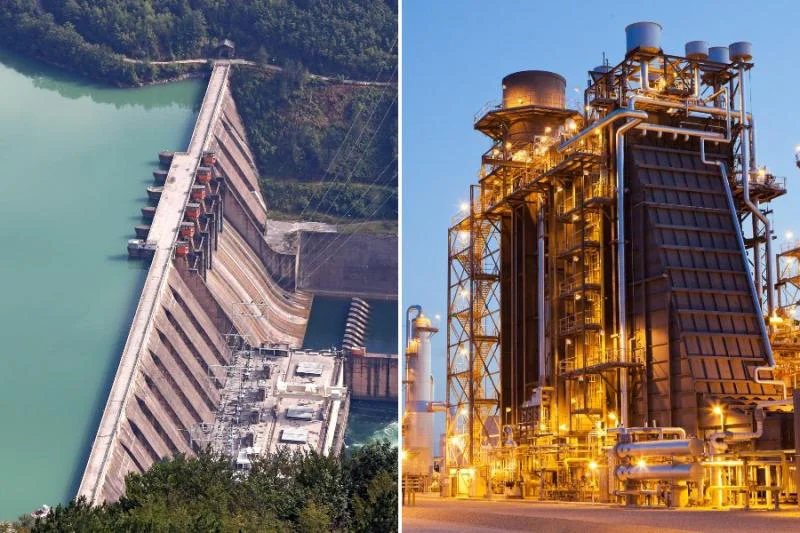The most important difference between hydroelectricity and power plants is how and where they get their energy. Hydroelectricity is made by turning the kinetic energy of moving water into electricity. This is usually done with dams or run-of-the-river systems. On the other hand, power plants include a wider range of facilities that make electricity using different energy sources, such as coal, natural gas, oil, nuclear, solar, wind, or geothermal. “Power plant” is a broad term that includes hydroelectric power stations. “Hydroelectricity,” on the other hand, is the specific name for electricity made by capturing the energy of moving water.
What is Hydro Electricity?
Hydroelectricity is a renewable form of energy that is made by using the kinetic energy of moving water to make electricity. This is usually done with dams or run-of-river systems. It is a reliable source of renewable energy that is used a lot and adds a lot to the world’s power supply.
A dam is usually built across a river in a hydroelectric power station. This makes a reservoir where water can be stored. When the water is let out of the reservoir, it flows through the turbines and makes them turn. The generators then use the rotational energy of the turbines to make electricity, which is then sent to the power grid.
Stream-flow systems don’t need big dams or reservoirs. Instead, they send a part of the river’s flow through a channel or pipeline to power turbines. The water is then sent back to the river downstream.
Hydroelectricity has many benefits, such as low greenhouse gas emissions, a steady and reliable power supply, and the ability to quickly change the amount of electricity produced to meet changes in demand. Also, dams can make reservoirs that can be used for things like flood control, irrigation, and recreation.
In short, hydroelectricity is a renewable energy source that makes electricity using moving water’s energy. It is a reliable way to produce good electricity for the environment and adds a lot to the world’s energy mix.
What is Power Plant?
A power plant also called a power station or generating station, is an industrial building that turns different kinds of energy into electricity. Power plants use a wide range of ways to make energy and sources of fuel, such as coal, natural gas, oil, the nuclear, hydroelectric, solar, wind, or geothermal energy.
Most of the time, making electricity involves turning the primary energy source into mechanical or thermal energy. This energy is then used to power a generator, turning mechanical or thermal energy into electrical energy. After the electricity is made, it is sent to the power grid so that it can be sent to homes, businesses, and public buildings.
Different types of power plants have different effects on the environment, costs, and how well they work. Fossil fuel power plants, for example, are a significant source of greenhouse gas emissions and air pollution. In contrast, renewable energy sources like solar, wind, and hydroelectric power plants produce fewer emissions and are better for the environment.
The term “power plant” refers to various ways to make energy. Each of these ways has its own environmental, economic, and operational features that add to the mix of energy that keeps our modern world running. In short, a power plant is an industrial building that makes electricity by turning different types of energy into electricity.
Difference Between Hydro Electricity and Power Plant
Hydroelectricity and conventional power plants are distinctive in several key respects, including the nature of their respective energy sources, their generation processes, and the power they provide. These differences have an effect on the ecology, economy, and efficiency of each power generation strategy.
Energy Sources
To produce electricity, hydroelectric plants use the kinetic energy of moving water. In contrast, power plants use various energy sources, such as fossil fuels (coal, natural gas, oil), nuclear, solar, wind, and geothermal power.
Generation Methods
Hydroelectric power stations use dams or “run-of-the-river” systems to generate electricity by channelling water flow through turbines. However, depending on the type of fuel used, nuclear reactions used, or solar panels installed, power plants use different methods to convert energy into a usable form.
Scope of Application
Hydroelectricity is one type of renewable energy that significantly contributes to the worldwide electricity grid. The phrase “power plant” refers to various facilities that generate electricity from multiple sources, including hydroelectric power stations.
Environmental Impact
The environmental impact of different power plants varies, but hydroelectricity is clean and renewable with low greenhouse gas emissions. Plants that use nuclear power create radioactive waste, while those that burn fossil fuels add to air pollution and climate change.
In conclusion, hydroelectricity and power plants vary significantly in terms of their energy sources, generating methods, and application areas. Power plants are a broader category of electricity-producing facilities that utilise many energy sources with varying environmental and operational features, including hydroelectricity.







